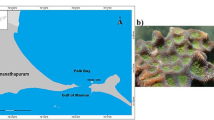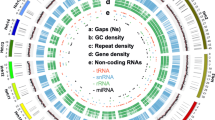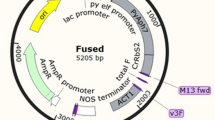Abstract
Background
Salinity is an essential abiotic stress in plants. Dunaliella is a genus of high-salt-tolerant microalgae. The present study aimed to compare the characterizations of D. bioculata and D. quartolecta at different levels and investigate novel genes response to salt stress.
Methods and results
High chlorophyll contents were detected in D. bioculata on the 35th d of salt stress, while high lipid and carotenoid contents were detected in D. quartolecta via morphological and biochemical analyses. Physiological analysis showed that D. quartolecta cells had a smaller increase in osmotic potential, a smaller decrease in the Na+/K+ ratio and photochemical efficiency (Fv/Fm), and a lower relative conductivity than D. bioculata cells. The genomic lengths of D. quartolecta and D. bioculata were 396,013,629 bp (scaffold N50 = 1954 bp) and 427,667,563 bp (scaffold N50 = 3093 bp) via high-throughput sequencing and de novo assembly, respectively. Altogether, 25,751 and 26,620 genes were predicted in their genomes by annotation analysis with various biodatabases. The D. bioculata genome showed more segmental duplication events via collinearity analysis. More single nucleotide polymorphisms and insertion-deletion variants were detected in the D. bioculata genome. Both algae, which showed a close phylogenetic relationship, may undergo positive selection via bioinformatics analysis. A total of 382 and 85 novel genes were screened in D. bioculata and D. quartolecta, with 138 and 51 enriched KEGG pathways, respectively. Unlike the novel genes adh1, hprA and serA, the relative expression of livF and phbB in D. bioculata was markedly downregulated as salinity increased, as determined by qPCR analysis. The relative expression of leuB, asd, pstC and proA in D. quartolecta was markedly upregulated with the same salinity increase.
Conclusion
Dunaliella quartolecta is more halophilic than D. bioculata, with more effective responses to high salt stress based on the multiphase comparative data.




Similar content being viewed by others
Availability of data and materials
The raw genome sequencing datasets in this study are available from the NCBI Sequence Read Archive (SRA) database with the accession numbers SRR12329620 and SRR12329789. The authors declare that all the other data supporting the findings of this study are available within the article and its supplementary files.
References
Ścieszka S, Klewicka E (2019) Algae in food: a general review. Crit Rev Food Sci Nutr 59(21):3538–3547. https://doi.org/10.1080/10408398.2018.1496319
Kim JH, Lee JE, Kim KH et al (2018) Beneficial effects of marine algae-derived carbohydrates for skin health. Mar Drugs 16(11):459. https://doi.org/10.3390/md16110459
Lenka SK, Carbonaro N, Park R et al (2016) Current advances in molecular, biochemical, and computational modeling analysis of microalgal triacylglycerol biosynthesis. Biotechnol Adv 34:1046–1063
Mao X, Zhang Y, Wang X et al (2020) Novel insights into salinity-induced lipogenesis and carotenogenesis in the oleaginous astaxanthin-producing alga Chromochloris zofingiensis: a multi-omics study. Biotechnol Biofuels 13:73. https://doi.org/10.1186/s13068-020-01714-y
Avron M (1986) The osmotic components of halotolerant algae. Trends Biochem Sci 11(1):5–6. https://doi.org/10.1016/0968-0004(86)90200-8
Glöckner G, Rosenthal A, Valentin K (2000) The structure and gene repertoire of an ancient red algal plastid genome. J Mol Evol 51(4):382–390. https://doi.org/10.1007/s002390010101
Kim GY, Heo J, Kim HS et al (2017) Bicarbonate-based cultivation of Dunaliella salina for enhancing carbon utilization efficiency. Biores Technol 237:72–77. https://doi.org/10.1016/j.biortech.2017.04.009
Oren A (2014) The ecology of Dunaliella in high-salt environments. J Biol Res (Thessalon) 21(1):23. https://doi.org/10.1186/s40709-014-0023-y(In Chinese)
Wang T, Feng J, Xie SL (2014) Effects on culture conditions for β-carotene contents of Dunaliella sp. Sci Technol Food Ind 24:177–181. https://doi.org/10.13386/j.issn1002-0306.2014.24.029
Sadka A, Himmelhoch S, Zamir A (1991) A 150 kilodalton cell surface protein is induced by salt in the halotolerant green alga Dunaliella salina. Plant Physiol 95(3):822–831. https://doi.org/10.1104/pp.95.3.822
Chen H, Jiang JG (2009) Osmotic responses of Dunaliella to the changes of salinity. J Cell Physiol 219(2):251–258. https://doi.org/10.1002/jcp.21715
Liang MH, Jiang JG (2017) Analysis of carotenogenic genes promoters and WRKY transcription factors in response to salt stress in Dunaliella bardawil. Sci Rep 7:37025. https://doi.org/10.1038/srep37025
Sui Y, Vlaeminck SE (2020) Dunaliella microalgae for nutritional protein: an undervalued asset. Trends Biotechnol 38(1):10–12. https://doi.org/10.1016/j.tibtech.2019.07.011
Monte J, Ribeiro C, Parreira C et al (2020) Biorefinery of Dunaliella salina: sustainable recovery of carotenoids, polar lipids and glycerol. Biores Technol 297:122509. https://doi.org/10.1016/j.biortech.2019.122509
Xu Y, Ibrahim IM, Wosu CI et al (2018) Potential of new isolates of Dunaliella salina for natural β-carotene production. Biology 7(1):14. https://doi.org/10.3390/biology7010014
Bohn T, Desmarchelier C, El SN et al (2019) β-Carotene in the human body: metabolic bioactivation pathways-from digestion to tissue distribution and excretion. Proc Nutr Soc 78(1):68–87. https://doi.org/10.1017/S0029665118002641
Kim D, Lim JW, Kim H (2019) β-Carotene inhibits expression of c-Myc and cyclin E in Helicobacter pylori-infected gastric epithelial cells. J Cancer Prev 24(3):192–196. https://doi.org/10.15430/JCP.2019.24.3.192
Raja R, Hemaiswarya S, Rengasamy R (2007) Exploitation of Dunaliella for beta-carotene production. Appl Microbiol Biotechnol 74(3):517–523. https://doi.org/10.1007/s00253-006-0777-8
Liang MH, Lu Y, Chen HH (2017) The salt-regulated element in the promoter of lycopene β-cyclase gene confers a salt regulatory pattern in carotenogenesis of Dunaliella bardawil. Environ Microbiol 19(3):982–989. https://doi.org/10.1111/1462-2920.13539.18
Li J, Lu Y, Xue L et al (2010) A structurally novel salt-regulated promoter of duplicated carbonic anhydrase gene 1 from Dunaliella salina. Mol Biol Rep 37(2):1143–1154. https://doi.org/10.1007/s11033-009-9901-z
Xing Z, Gao X, Wang M et al (2020) Identification of salt-responsive genes using transcriptome analysis in Dunaliella viridis. J Appl Phycol 32(5):2875–2887. https://doi.org/10.1007/s10811-020-02142-z
Santín-Montanyá I, Sandín-España P, García Baudín JM et al (2007) Optimal growth of Dunaliella primolecta in axenic conditions to assay herbicides. Chemosphere 66(7):1315–1322. https://doi.org/10.1016/j.chemosphere.2006.07.019
Khan AK, Kausar H, Jaferi SS et al (2020) An insight into the algal evolution and genomics. Biomolecules 10(11):1524. https://doi.org/10.3390/biom10111524
Polle JEW, Barry K, Cushman J et al (2017) Draft nuclear genome sequence of the halophilic and beta-carotene-accumulating green alga Dunaliella salina strain CCAP19/18. Genome Announc 5(43):e01105-e1117. https://doi.org/10.1128/genomeA.01105-17
Wang T, Feng J, Xie SL (2014) Effects on culture conditions for β-carotene contents of Dunaliella sp. Sci Technol Food Ind 35(24):177–181. https://doi.org/10.13386/j.issn1002-0306.2014.24.029(In Chinese)
Yin XG (2019) Physiological and biochemical and phylogentic studies of different strains of Dunaliella. Shanxi University, Taiyuan
Gao F, Nan F, Feng J et al (2021) Transcriptome profi le of Dunaliella salina in Yuncheng Salt Lake reveals salt-stress-related genes under different salinity stresses. J Oceanol Limnol. https://doi.org/10.1007/s00343-021-0164-4
Nayaka S, Upreti DK (2008) Diversity and ecophysiology of lichens in Schirmacher Oasis, Antarctica. Ministry of Earth Sciences. Technical Publication No. 26, pp 305–326. https://www.researchgate.net/publication/342242589_Diversity_and_ecophysiology_of_lichens_in_Schirmacher_Oasis_Antarctica
Munns R, Wallace PA, Teakle NL et al (2010) Measuring soluble ion concentrations (Na(+), K(+), Cl(-)) in salt-treated plants. Methods Mol Biol 639:371–382. https://doi.org/10.1007/978-1-60761-702-0_23
Li G, Wang G, Song L et al (2002) Lipid peroxidation in microalgae cells under simulated microgravity. Space Med Med Eng (Beijing) 15(4):270–272. https://doi.org/10.1007/s11769-002-0038-4
Yu Z, Zhang T, Zhu Y (2020) Whole-genome re-sequencing and transcriptome reveal cadmium tolerance related genes and pathways in Chlamydomonas reinhardtii. Ecotoxicol Environ Saf 191:110231. https://doi.org/10.1016/j.ecoenv.2020.110231
Mera R, Torres E, Abalde J (2016) Effects of sodium sulfate on the freshwater microalga Chlamydomonas moewusii: implications for the optimization of algal culture media. J Phycol 52(1):75–88. https://doi.org/10.1111/jpy.12367
Gao Y (2019) Effects of nitrogen deprivation and nutrition way on the lipid accumulation of Parachlorella kessleri TY. Thesis for doctor’s degree, Shanxi University, Taiyuan, 2019 (in Chinese). https://doi.org/10.27284/d.cnki.gsxiu.2019.001530
Yu Z, Zhang T, Hao R et al (2019) Sensitivity of Chlamydomonas reinhardtii to cadmium stress is associated with phototaxis. Environ Sci Process Impacts 21:1011–1020. https://doi.org/10.1039/c9em00013e
Xie Y, Wu G, Tang J et al (2014) SOAP denovo-Trans: de novo transcriptome assembly with short RNA-Seq reads. Bioinformatics 30(12):1660–1666. https://doi.org/10.1093/bioinformatics/btu077
Simpson JT, Wong K, Jackman SD et al (2009) ABySS: a parallel assembler for short read sequence data. Genome Res 19(6):1117–1123. https://doi.org/10.1101/gr.089532.108
Tarailo-Graovac M, Chen N (2009) Using RepeatMasker to identify repetitive elements in genomic sequences. Curr Protoc Bioinform. https://doi.org/10.1002/0471250953.bi0410s25
Stanke M, Keller O, Gunduz I et al (2006) AUGUSTUS: ab initio prediction of alternative transcripts. Nucleic Acids Res 34:W435–W439. https://doi.org/10.1093/nar/gkl200
Buchfink B, Xie C, Huson DH (2015) Fast and sensitive protein alignment using DIAMOND. Nat Methods 12(1):59–60. https://doi.org/10.1038/nmeth.3176
Huerta-Cepas J, Szklarczyk D, Heller D et al (2019) eggNOG 5.0: a hierarchical, functionally and phylogenetically annotated orthology resource based on 5090 organisms and 2502 viruses. Nucleic Acids Res 47(1):309–314. https://doi.org/10.1093/nar/gky1085
Emms DM, Kelly S (2015) OrthoFinder: solving fundamental biases in whole genome comparisons dramatically improves orthogroup inference accuracy. Genome Biol 16(1):157. https://doi.org/10.1186/s13059-015-0721-2
Letunic I, Bork P (2016) Interactive tree of life (iTOL) v3: an online tool for the display and annotation of phylogenetic and other trees. Nucleic Acids Res 44(W1):W242-245. https://doi.org/10.1093/nar/gkw290
Li H, Handsaker B, Wysoker A et al (2009) The sequence alignment/map format and SAMtools. Bioinformatics 25(16):2078–2079. https://doi.org/10.1093/bioinformatics/btp352
Narasimhan V, Danecek P, Scally A et al (2016) BCFtools/RoH: a hidden Markov model approach for detecting autozygosity from next-generation sequencing data. Bioinformatics 32(11):1749–1751. https://doi.org/10.1093/bioinformatics/btw044
Li H, Durbin R (2010) Fast and accurate long-read alignment with Burrows-Wheeler transform. Bioinformatics 26(5):589–595. https://doi.org/10.1093/bioinformatics/btp698
Wang Y, Tang H, Debarry JD et al (2012) MCScanX: a toolkit for detection and evolutionary analysis of gene synteny and collinearity. Nucleic Acids Res 40(7):e49. https://doi.org/10.1093/nar/gkr1293
Husseneder C, Mcgregor C, Lang RP (2012) Transcriptome profiling of female alates and egg-laying queens of the Formosan subterranean termite. Compar Biochem Physiol Part D 7(1):14–27. https://doi.org/10.1016/j.cbd.2011.10.002
Wang W, Xing L, Xu K et al (2020) Salt stress-induced H2O2 and Ca2+ mediate K+/Na+ homeostasis in Pyropia haitanensis. J Appl Phycol 32(6):1–12. https://doi.org/10.1007/s10811-020-02284-0
Spielman SJ, Wilke CO (2015) The relationship between dN/dS and scaled selection coefficients. Mol Biol Evol 32(4):1097–1108. https://doi.org/10.1093/molbev/msv003
Ma L, Zhang H, Sun L et al (2012) NADPH oxidase AtrbohD and AtrbohF function in ROS-dependent regulation of Na+/K+ homeostasis in Arabidopsis under salt stress. J Exp Bot 63(1):305–317. https://doi.org/10.1093/jxb/err280
Li L, Zhang X, He N et al (2019) Transcriptome profiling of the salt-stress response in the halophytic green alga Dunaliella salina. Plant Mol Biol Report 37(5):421–435. https://doi.org/10.1007/s11105-019-01168-z
Pick U, Zarka A, Boussiba S et al (2019) A hypothesis about the origin of carotenoid lipid droplets in the green algae Dunaliella and Haematococcus. Planta 249(1):31–47. https://doi.org/10.1007/s00425-018-3050-3
Hashimoto H, Uragami C, Cogdell RJ (2016) Carotenoids and photosynthesis. Subcell Biochem 79:111–139. https://doi.org/10.1007/978-3-319-39126-7_4
Sudhir PR, Pogoryelov D, Kovacs L et al (2005) The effects of salt stress on photosynthetic electron transport and thylakoid membrane proteins in the cyanobacterium Spirulina platensis. J Biochem Mol Biol 38(4):481–485. https://doi.org/10.5483/bmbrep.2005.38.4.481
Chen H, Lu Y, Jiang JG (2012) Comparative analysis on the key enzymes of the glycerol cycle metabolic pathway in Dunaliella salina under osmotic stresses. PLoS ONE 7(6):e37578. https://doi.org/10.1371/journal.pone.0037578
Takagi M, Karseno YT (2006) Effect of salt concentration on intracellular accumulation of lipids and triacylglyceridein marine microalgae Dunaliella cells. J Biosci Bioeng 101(3):223–226. https://doi.org/10.1263/jbb.101.223
Acknowledgements
The authors would like to thank Vikas Narang (Editage) and for editorial assistance with the English. Additionally, the authors are thankful to all members at the Institute of Hydrobiology, Chinese Academy of Sciences and BGI for supporting algae strain identification and genome sequencing.
Funding
This work was supported by the National Natural Science Foundation of China (Grant No. 31670208), the Applied Basic Research Programs of Shanxi Province of China (Grant No. 201801D221242), Scientific and Technological Innovation Programs of Higher Education Institutions in Shanxi of China (Grant No. 2019L0041) and the Shanxi “1331 Project”. Xie S., the corresponding author, was supported by the National Natural Science Foundation of China (Grant No. 41871037) and the Shanxi “1331 Project”. Gao F., the first author, was supported by the Applied Basic Research Programs of Shanxi Province of China and Scientific and Technological Innovation Programs of Higher Education Institutions in Shanxi of China.
Author information
Authors and Affiliations
Contributions
FG performed the experiments, analyzed the data and cowrote the manuscript; FN, JF, JL, QL and XL analyzed the data; SX supervised the project and revised the manuscript. All authors read and approved the final manuscript.
Corresponding author
Ethics declarations
Conflict of interest
The authors declare no conflicts of interest.
Ethical approval
All algae sampling procedures in this study were in accordance with the guidelines for the care and use of laboratory plants of Shanxi University, and samples were obtained from CCAP (UK) and UTEX (USA) with their permission.
Additional information
Publisher's Note
Springer Nature remains neutral with regard to jurisdictional claims in published maps and institutional affiliations.
Supplementary Information
Below is the link to the electronic supplementary material.
Rights and permissions
About this article
Cite this article
Gao, F., Nan, F., Feng, J. et al. Comparative morphological, physiological, biochemical and genomic studies reveal novel genes of Dunaliella bioculata and D. quartolecta in response to salt stress. Mol Biol Rep 49, 1749–1761 (2022). https://doi.org/10.1007/s11033-021-06984-9
Received:
Accepted:
Published:
Issue Date:
DOI: https://doi.org/10.1007/s11033-021-06984-9




